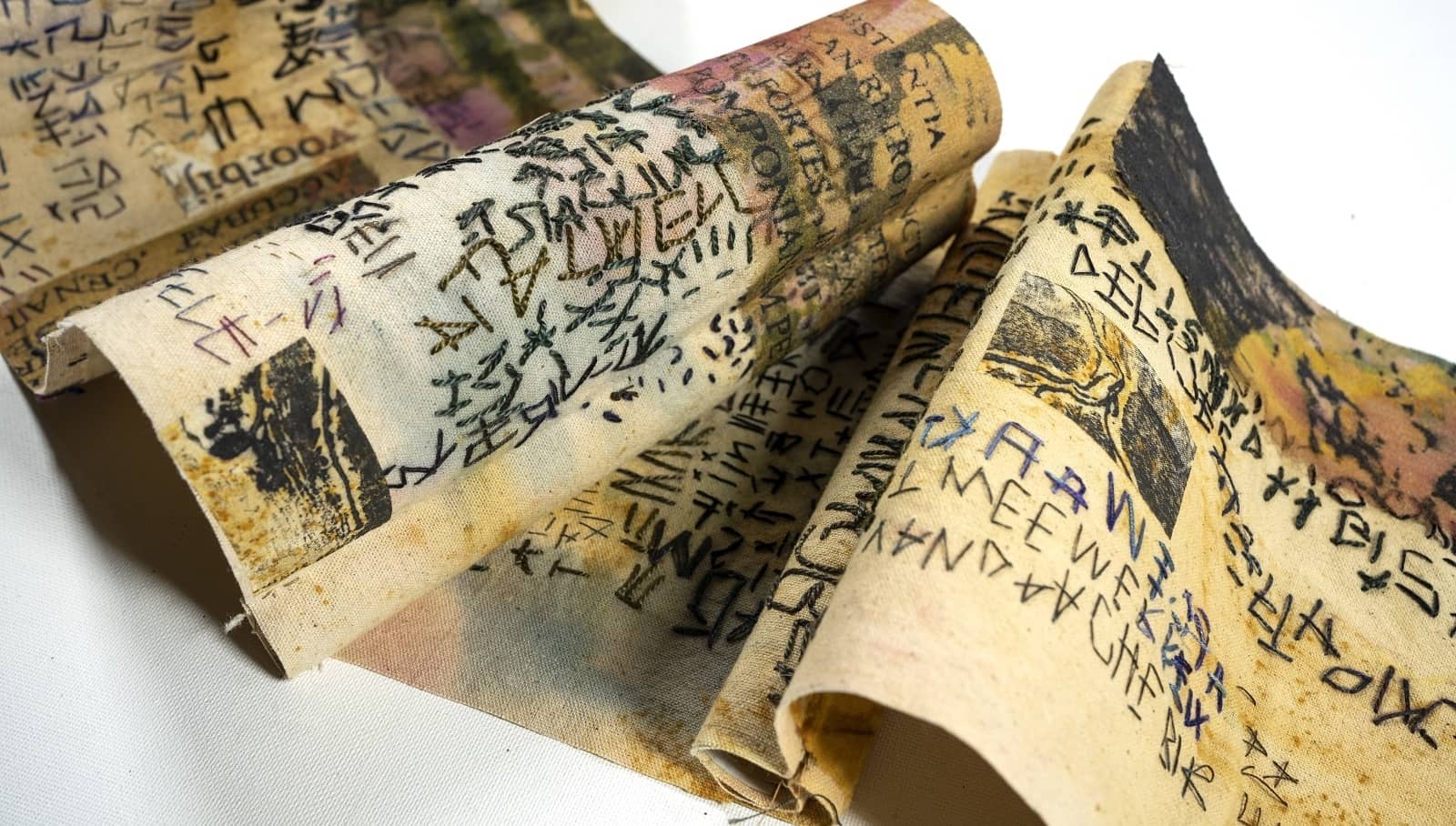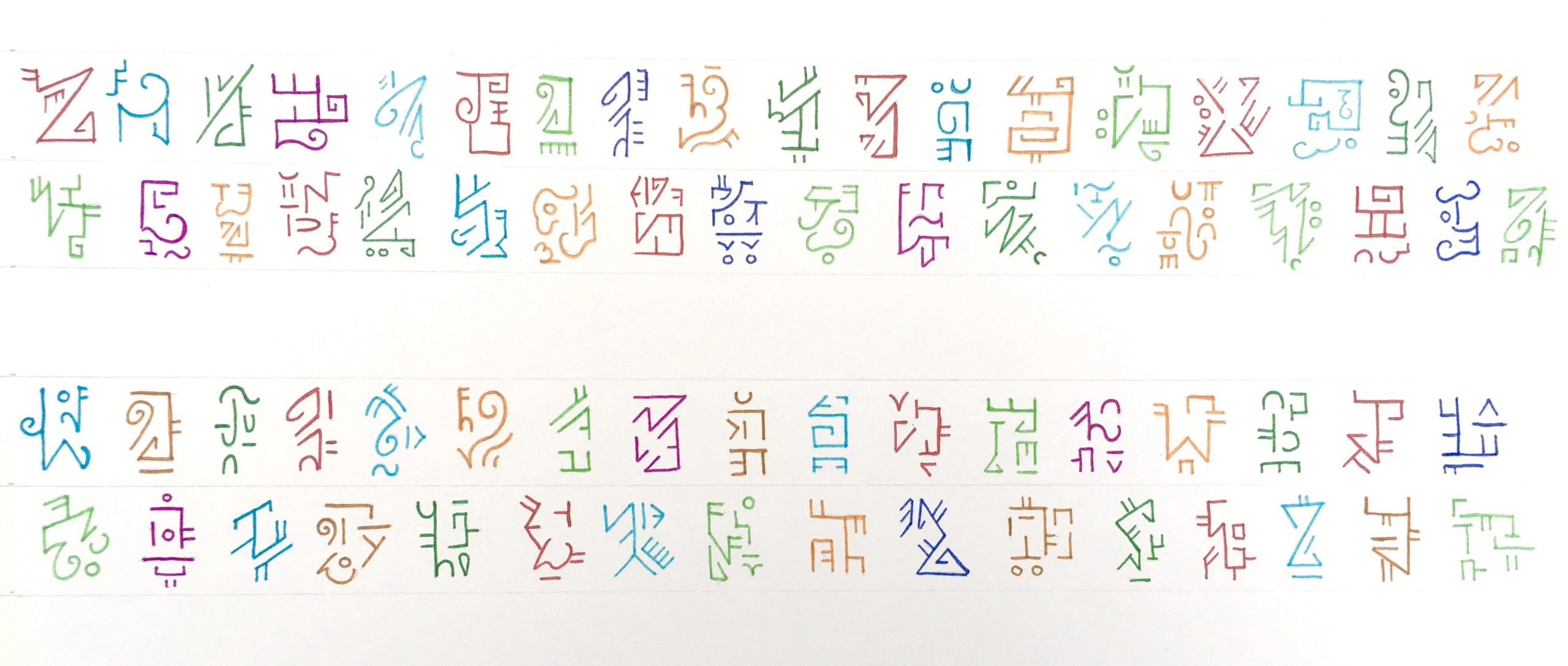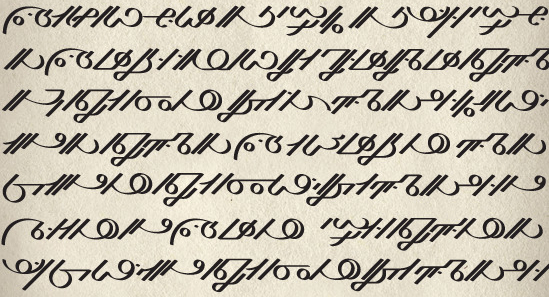
Artwork featuring asemic writing by Els van Baarle
Asemic writing is, by definition, meaningless. It is wordless writing. But what attracts artists and viewers alike to the art form is the way that certain marks can appear meaningful. The scrawls and strokes can be so reminiscent of a natural language or system of glyphs that they look as if they could be read – if only one was well versed in it. This is because this art form often utilises the gesture(s) of writing that is familiar to all of us, be that the kinds of strokes and shapes we make, the repetition of them, the ‘flow’ of writing (as in cursive), joining characters into discrete words, the spaces between words, the creation of sentences, the beginning and end of sentences, and so forth and so on.
The rules, constraints, and conventions of writing are what we use to express our thoughts, and by following these patterns, asemic writing can also look like a representation of what an individual is thinking or feeling.
It is the gestures of writing, as well as the intention and emotions that the artist brings to the act of writing, that is what allows us to ‘read’ an asemic artwork (or at least, give us the impression or feeling of reading). Peter Schwenger – resident fellow at the University of Western Ontario’s Centre for the Study of Theory and Criticism – devotes a chapter in his book Asemic: The Art of Writing to the implications of reading asemic artwork. In this chapter, he refers to Luigi Serafini’s Codex Seraphinianus, one of the most scrutinised art books, due in large part to the language-like writing that appears throughout, which people have tried to decipher since the book’s publication.
The repeated attempts at decoding Serafini’s Codex have served to further deepen the mystery surrounding it. But Serafini has confirmed that the writing is asemic; there is no way to decode it because the writing only has the (very strong) appearance of a genuine language. It is not a constructed language in the way that Quenya/Sindarin (Elvish) or Klingon are. Serafinian, as his asemic writing is called, does not have phonology, grammar, and vocabulary associated with it. As Serafini himself has said:
I’d call it a written dream. An image of something that has been deformed, and yet is very recognizable. The writing itself is vaguely reminiscent of Arabic script, although it is entirely the fruit of my imagination. And the strange thing is that it sort of looks realistic, intelligible. In fact a few people have actually studied it in some detail and have discovered that there are certain shapes, certain signs that are recurrent and that give the impression of real words and a kind of syntax.
Schwenger points out that Serafini’s creative process involved the emphasis on childhood sensations related to writing and reading, rather than wanting to create a secret language that could be deciphered. Nevertheless, Schwenger reminds us that the “ultimate dream, of course, is that this apparently authoritative text is capable of being decoded.” This promise of esoteric knowledge becomes a kind of strategy that asemic artists draw on, emulating those ancient alchemical treatises that could only be deciphered by a select few – those worthy of the teachings. Serafini’s Codex epitomises this wish.
Asemic writing, then, is often born out of – and interpreted in light of – our desire for the esoteric. There is something fantastically enticing about the discovery of secret texts and alien languages. (See my previous post on asemic writing and xenoglyphs for more on the otherworldly aspect of this art form.) Strange glyphs can give us an intimation of meaning, the promise of translation, a revelation on the horizon. Certain intricate glyphs may also resemble the sigils (symbols) used in ritual magic, created and assembled in a way that represents and summons supernatural entities like demons and angels (as in medieval magic) or the practitioner’s desired outcome (in modern usage, as developed by Austin Osman Spare).
I have continued to experiment with making asemic glyphs that have a sigil-like quality to them, although that aspect hasn’t been intentional. But there is still something appealing about the idea – not the actual belief, as in ritual magic – that each glyph represents an entity; each one acting as a symbol that can be activated, summoning the entity in question.

Some asemic glyphs I created
Spare interpreted the entities evoked by the medieval practice of magic as complexes in the unconscious, which could be actively created through the creation of sigils. His intention was not to use sigils to control demons and angels but for controlling forces in the unconscious psyche. Interestingly, Spare’s technique of creating and using sigils influenced the artist Brion Gysin, who was one of the pioneers of asemic writing.
Moreover, asemic writing, since its beginnings (i.e. with Henri Michaux) has been concerned with automatic writing (producing writing in an unconscious, trance-like state), which both the Surrealists and those in the occult (e.g. mediums) showed a penchant for. However, the Surrealists believed they were gaining access to unconscious contents by bypassing logic, aesthetic conventions, and social inhibitions, allowing for the direct transcription of unconscious thoughts and desires, whereas mediums felt they were communicating with spirits, and these spirits would take control of the medium’s hand and write through them. This is known as spirit writing. One medium recounts the following experience with automatic writing during a séance:
. . . the table we surrounded soon began to oscillate rapidly. My right arm was seized with a convulsive tremor, and then in a ‘positive condition’ it refused obedience to my will . . . A pencil and paper were lying on the table. The pencil came into my hand: my fingers were clenched on it! An unseen iron grasp compressed the tendons of my arm: my hand was flung violently forward on the paper, and I wrote meaning[ful] sentences, without any intention, or knowing what they were to be . . . my hand rested on a cloud, while my guardian-spirit … dictated to me.
André Breton, the co-founder of Surrealism, took a more secular approach to the practice of automatic writing, viewing it as a way to explore the forces of the unconscious mind, achieved by writing spontaneously before logic can take over. This is often the goal of asemic writing as well.
Yet the allure of asemic writing, for many artists and viewers, is that these expressions of the unconscious – best transcribed automatically – are perceived to be esoteric in nature. Of course, it is not that one needs special initiation, knowledge, or learning in order to translate these odd marks, as in the case of cryptic alchemical texts, where a definite meaning will arise. Asemic texts don’t work in this way. They are illegible and, therefore, cannot have a set meaning. Unlike esoteric writing and reading, in which meaning is reserved for initiates who understand a secret code, reading asemic works is always about translating into words “the emotional effect of the marks before our eyes,” as Schwenger states. This is something we are all capable of doing.
There still remains, however, the dream – the fantasy – of the esoteric. Asemic writing holds the promise of the esoteric without ever truly delivering it. Yet this tension is, I believe, part of the reason why this art form is so distinct and appealing. It gives the impression of secrecy, of hidden meaning, making you want the artist to reveal what the symbols mean exactly. Nonetheless, the reality is that it is often up to the viewer to decide what they mean, which can sometimes amount to a kind of Rorschach test (which feels especially fitting in the more abstract and ambiguous works, like the calligraphic works created by Michaux or Tim Gaze, with the former being a source of inspiration to the latter).

Artwork by Christopher Skinner
Asemic writing is ‘readable’ in a way that neither writing nor other forms of abstract art are. The atmosphere of the esoteric is, I think, further created due to the fact that asemic writing blurs the line between writing and art; it simultaneously evokes the impulse to read and the reaction of aesthetic appreciation. To translate this hybrid art form, then, would appear to require a special kind of perspective – an aesthetic form of ‘reading’.
In asemic texts, we can see the striving for communication, yet the ‘communication’ that appears is totally unfamiliar, even though it still emanates a sense of translatability, direction, content, and specificity. The same could be said of the sigils used in ceremonial magic. For instance, the 72 sigils from the Lesser Key of Solomon, which give instructions for the evocation of 72 demons, appear to point to or gesture at something at first glance.
Yet whereas the sigils have a logic to them, asemic writing does not follow a clear structure or path. The meaning of asemic marks and glyphs is ambiguous, not readable only to a few but open to anyone’s interpretation and, therefore, able to generate a multiplicity of meanings.
I discovered asemic writing today and lost many hours to it, including this morning -on the crossword and games page – where I remembered the Word Crimes book coming to me by mail. The pundits of this new writing might scoff at such coincidences. Others, it happens, may coin it as emblem, entry, badge or citation, which I prefer.
Now that I’ve seen for myself, I add the magical listicle written by Jorge Luis Borges in his “Celestial Emporium of Benevolent Knowledge,” which divides all animals into 14 categories. One good route is:
https://en.m.wikipedia.org/wiki/Celestial_Emporium_of_Benevolent_Knowledge
Author
Hi Chris, thanks for sharing this link. I’m a big fan of Borges’ work and imagination.
Back to Future